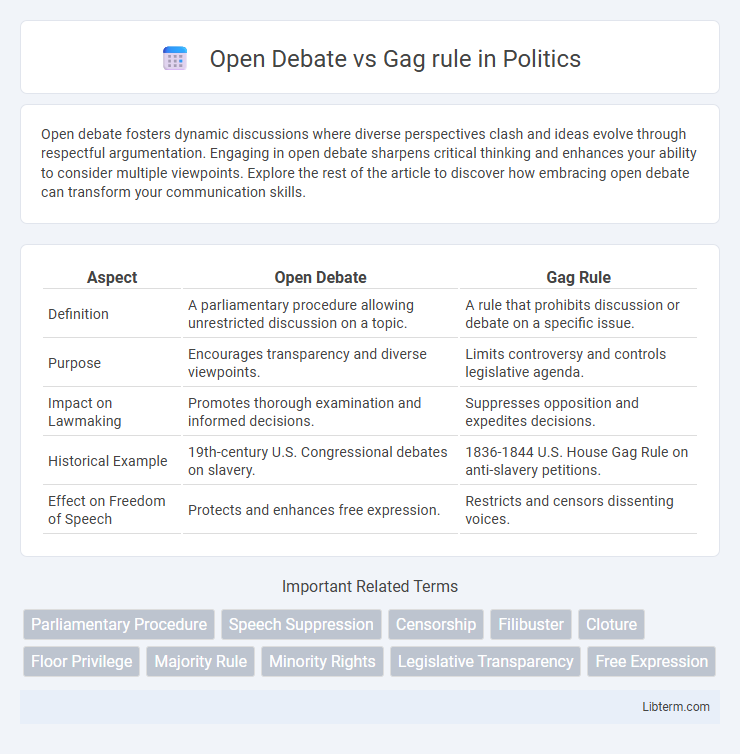Open debate fosters dynamic discussions where diverse perspectives clash and ideas evolve through respectful argumentation. Engaging in open debate sharpens critical thinking and enhances your ability to consider multiple viewpoints. Explore the rest of the article to discover how embracing open debate can transform your communication skills.
Table of Comparison
| Aspect | Open Debate | Gag Rule |
|---|---|---|
| Definition | A parliamentary procedure allowing unrestricted discussion on a topic. | A rule that prohibits discussion or debate on a specific issue. |
| Purpose | Encourages transparency and diverse viewpoints. | Limits controversy and controls legislative agenda. |
| Impact on Lawmaking | Promotes thorough examination and informed decisions. | Suppresses opposition and expedites decisions. |
| Historical Example | 19th-century U.S. Congressional debates on slavery. | 1836-1844 U.S. House Gag Rule on anti-slavery petitions. |
| Effect on Freedom of Speech | Protects and enhances free expression. | Restricts and censors dissenting voices. |
Understanding Open Debate and Gag Rule
Open Debate fosters a transparent and inclusive discussion environment where all perspectives and ideas can be freely expressed and examined. In contrast, a Gag Rule imposes strict limitations on topics and speech, often silencing dissenting opinions and restricting open communication. Understanding these concepts highlights the critical balance between encouraging diverse viewpoints and maintaining order within legislative or organizational forums.
Historical Context of Open Debate
The historical context of open debate dates back to the early democratic practices of ancient Greece, where citizens engaged in public discussions to shape policy decisions and ensure transparency. In the U.S. Congress, open debate evolved as a fundamental principle to promote free speech and prevent authoritarian control, allowing diverse viewpoints to be expressed before legislation passes. This tradition contrasts sharply with gag rules, such as the 1836 congressional gag rule, which suppressed discussions on slavery and highlighted the tension between open debate and political censorship.
Origins and Implications of Gag Rule
The Gag Rule, established in the 1830s by the U.S. House of Representatives, originated as a response to heated abolitionist petitions seeking to end slavery, effectively prohibiting discussion on this highly contentious issue. Its implementation aimed to suppress anti-slavery debate, preserving the political status quo but intensifying sectional tensions that contributed to the Civil War. The rule's implications included limiting free speech within the legislative process and provoking significant opposition from figures like John Quincy Adams, who championed open debate as a democratic necessity.
Key Differences Between Open Debate and Gag Rule
Open Debate promotes free discussion, allowing all participants to express diverse viewpoints without restrictions, fostering transparency and democratic decision-making. In contrast, the Gag Rule imposes limits on speech by prohibiting specific topics or criticisms, often stifling dissent and curbing open dialogue. The key difference lies in Open Debate encouraging comprehensive participation, while the Gag Rule enforces silence or censorship to control the narrative.
Impact on Freedom of Speech
Open Debate fosters a robust environment for freedom of speech by encouraging diverse viewpoints and transparent discussions, which are essential for democratic engagement and informed decision-making. In contrast, Gag Rules restrict speech by limiting topics or opinions, often suppressing dissent and hindering the exchange of ideas vital for social and political progress. The imposition of Gag Rules can lead to censorship and a weakened public discourse, undermining fundamental rights to expression and participation.
Political Consequences of Gag Rules
Gag rules, which prohibit discussion or criticism of specific topics, severely limit political transparency and hinder democratic accountability by suppressing dissenting voices and curtailing open debate in legislative bodies. These restrictions often lead to increased political polarization, as marginalized groups and opposition parties find alternative means to express grievances, sometimes through protests or underground movements. Governments imposing gag rules risk eroding public trust and provoking widespread civil unrest, ultimately weakening institutional legitimacy and democratic governance.
Benefits of Encouraging Open Debate
Encouraging open debate fosters a diverse exchange of ideas that enhances critical thinking and drives innovation in democratic societies. Open debates promote transparency, accountability, and public engagement by allowing multiple perspectives to be aired freely without censorship. This environment cultivates informed decision-making and supports the development of more effective policies by integrating varied viewpoints.
Case Studies: Open Debate vs Gag Rule in Action
Case studies such as the civil rights movement in the United States demonstrate the powerful impact of open debate in fostering social change and protecting free speech. In contrast, authoritarian regimes employing gag rules, like China's censorship of pro-democracy activists, illustrate how restricting open discourse suppresses dissent and hinders democratic progress. Analyzing these examples highlights the critical role of open debate in advancing transparency, accountability, and human rights worldwide.
Public Perception and Social Outcomes
Open debate fosters transparency and encourages diverse viewpoints, enhancing public trust and democratic engagement. Conversely, the gag rule restricts free expression, often leading to public skepticism and diminished civic participation. Social outcomes under open debate typically include increased collaboration and policy innovation, while gag rules can result in polarization and social unrest.
Striking a Balance: Toward Inclusive Discourse
Open debate fosters inclusive discourse by encouraging diverse perspectives and critical thinking, essential for democratic decision-making. Gag rules, while intended to maintain order, often limit free expression and marginalize minority voices, undermining the richness of dialogue. Striking a balance requires creating frameworks that protect open discussion without allowing disruptive or harmful speech to dominate the conversation.
Open Debate Infographic

 libterm.com
libterm.com